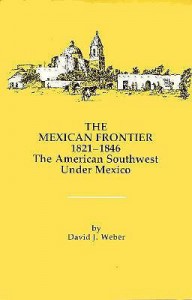When the Southwest was the far north

Before the American Southwest was the American Southwest it was the northern frontier of Mexico, representing a third of the territory of the country after its leaders declared their independence from Span in 1821. What the region was like in the quarter century between its possession by Spain and its conquest by the United States is the subject of David J. Weber's book. It's a comprehensive work that begins by examining how the news of Augustin de Iturbide's declaration of independence was received in the region and concludes with the outbreak of the war that would lead to the U.S.'s annexation of the territory.
While Weber's text surveys the span of human activity in the territory, two themes emerge over the course of his text. The first is the sense of isolation for the Hispanic residents of the region. Independence was a fait accompli for them, one in which they had no say. In many ways little changed with the news, as the region went from being the sparsely settled northern region of Spain's empire in the Americans to the sparsely settled northern lands of the United States of Mexico. Many of the key issues and developments that defined the area during the last decades of Spanish control continued, with the Mexicans dealing with economic change and relations the Indians just as they had before. While independence meant shifts in the dynamics involved, these were concerns that engaged locals no matter who was in charge,
What changed most with Mexican independence was its relations with the United States. This emerges as the second theme of the book: the growing drift of the region into the U.S. orbit. Independence from Spain meant an end to the mercantilist policies restricting trade with the United States, just as the presence of Americans on the frontier was growing. American merchants and trappers eagerly entered the region in search of economic opportunities, establishing a visible presence for the U.S. while economically orienting the region to the northeast. Close behind them were American settlers, whose presence in Texas in particular disrupted the dynamics of the region. Mexican authorities were conflicted about this presence, welcoming the economic benefits brought by trade and the stabilizing effects of non-Indian settlement while increasingly wary of what would follow from the growing American interest in the region. Their concerns would be validated with the outbreak of war in 1846, as the American presence served as the wedge for annexation two years later.
Weber makes plain the factors that led to the region's takeover by the United States, yet this is only one of his book's many strengths. For while Weber details the growing interest in the region by many Americans it also tells the story of the residents themselves and the lives they led. His chapters highlight the many challenges they faced, from their limited resources to the indifference with which they were often treated by Mexican institutions and the leadership of the Roman Catholic Church. Such coverage illustrates the challenges of life on the frontier in the early 19th century while underscoring how annexation came about. In all it makes Weber's book essential reading for anyone interested in the region, as he fills in the valuable details of what proved a critical period of transition in its history.
 1
1






